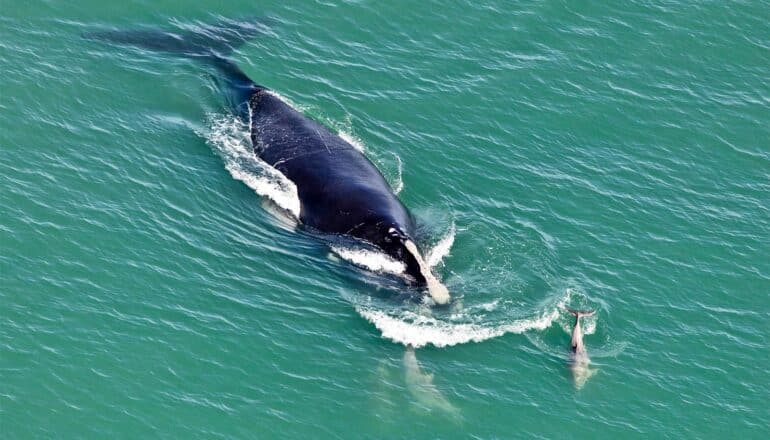
Marine researchers have mapped the population density of North Atlantic right whales worldwide in an effort to predict and help avoid harmful, even fatal, exposure to commercial fishing and vessel strikes.
The researchers pooled 17 years of available visual survey data covering 9.7 million square kilometers of the US Atlantic—roughly the same area as the entire contiguous United States.
This information was coupled with auditory data from almost 500 hydrophone recorders in US Atlantic waters that captured whales’ calls. Lining up visual and acoustic datasets for the first time, researchers built a statistical model to estimate the number of whales per square kilometer at different points in time.
“The more accurate and detailed the mapping, the better chance we have to save dwindling numbers of right whales from preventable injury and fatality,” says Patrick Halpin, director of the Marine Geospatial Ecology Lab at Duke University.
The lab studies marine ecology, resource management, and ocean conservation, using data to inform ocean management and governance. Other current real-time efforts to track and protect the whales from deadly encounters with human activities have been incomplete or ineffective.
Electronic tagging can harm whale health, and it is infeasible to continuously monitor more than a small fraction of the population that way.
The statistical model is a revision of a 2016 model that predicts whale density from environmental data, like sea surface temperature. This latest version incorporates new data to reflect whales’ changing migration and feeding patterns, including their presence in new areas that lack protection measures for marine life.
“With nearly three times more aerial survey data than we had before, and confirming evidence from the hydrophones, we were able to show how strongly the population has shifted its distribution,” says Jason Roberts, a Duke research associate and lead author of the study published in the journal Marine Ecology Progress Series.
Right whales maintain the health and balance of marine environments and the entire food web through their feeding habits. As climate change has reduced the population of their prey, whale migration patterns have become more unpredictable, increasing the chances that human activities, like commercial fishing, may harm whale health and chances of reproduction.
Using maps obtained by satellite ocean monitoring, or from physical ocean models like the recently published one, researchers can more accurately predict whale density across the US east coast.
The National Marine Fisheries Service, known as NOAA Fisheries, a federal agency within the National Oceanic and Atmospheric Administration, uses this model to assess and mitigate risks to large whales posed by activities such as trap and pot fishing, vessel traffic, naval testing and training, and offshore energy activities.
This research supports NOAA Fisheries’ overarching North Atlantic Right Whale Road to Recovery, which describes the agency’s efforts to address threats to the species, and monitor recovery progress.
In the United States, the Marine Mammal Protection Act prohibits intentional harming or disturbance (known as “takes”) of marine mammals by human activity, and limits takes that happen incidentally.
NOAA Fisheries estimates the number of accidental occurrences of whales harmed, and implements measures to minimize harm. Endangered North Atlantic right whales are approaching extinction.
Elevated right whale deaths triggered an Unusual Mortality Event in 2017. In recent years, 125 whales have died or been seriously injured, mostly from entanglements in fishing gear and being struck by vessels in both US and Canadian waters.
NOAA Fisheries and the US Navy funded the study.
Source: Duke University
The post New mapping could help protect one of the most endangered whales appeared first on Futurity.
from Futurity https://ift.tt/1fhuKjH
No comments:
Post a Comment